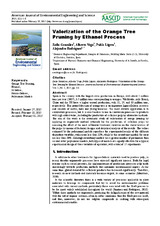Valorization of the Orange Tree Pruning by Ethanol Process
Autor
González, Zoilo
Vega, Alberto
Ligero, Pablo
Rodríguez, A.
Editor
American Association for Science and TechnologyFecha
2015Materia
Orange tree pruningEthanol
Cellulose
Hemicelluloses
Polynomial models
METS:
Mostrar el registro METSPREMIS:
Mostrar el registro PREMISMetadatos
Mostrar el registro completo del ítemResumen
Spain is the country with the largest citrus production in Europe, with about 5 million
tons per year (2007), 3.5 million tons corresponding to oranges. Worldwide, only Brazil,
China and the US have a higher annual production, with 21, 19, and 10 million tons,
respectively. This pruned fraction of orange tree is an important lignocellulosic resource
and consists of leaves, bark and young branches. The most obvious application is in
combustion processes, but it is also feasible to use in conversion processes to products
with high added value, including the production of cellulose pulp by alternative methods.
The aim of this work is the systematic study of valorisation of orange pruning by
applying an organosolv method (ethanol) for the production of cellulose pulps by
assessing the effect of the most influential treatment variables on the characteristics of
the pulps by means of factorial designs and statistical analysis of the results. The values
estimated by the polynomial models reproduce the experimental results of the different
dependent variables, with errors less than 22%, while by the neurofuzzy models the error
are less than 20%. Although neurofuzzy models use a greater number of parameters than
second order polynomial models, both types of models are equally effective for a typical
experimental design of three variables of operation, with a total of 15 experiments.

